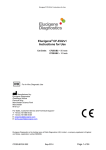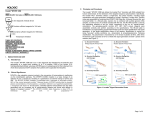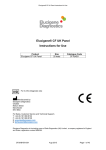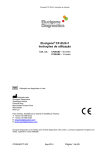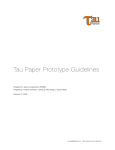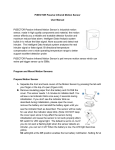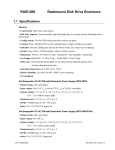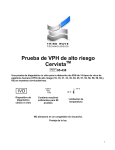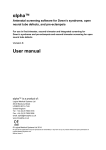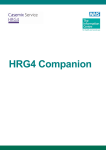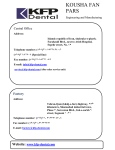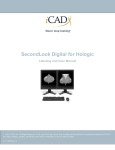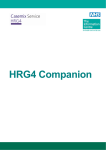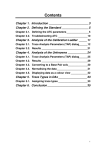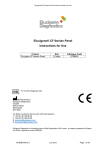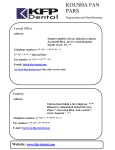Download Hologic CF IVD Package Insert
Transcript
HOLOGIC InPlex® CF Molecular Test 96 Tests Catalog No. 95-432 Reference Non-Hispanic Caucasian Ashkenazi Pan-Ethnic F508 1 72.42 54.38 44.07 38.95 31.41 66.31 R560T 1 0.38 0 0.17 0 0 0.3 2789+5G>A 1 0.48 0.16 0 0 0.1 0.38 N1303K 1 1.27 1.66 0.35 0.76 2.78 1.27 3849+10kbC>T 1 0.58 1.57 0.17 5.31 4.77 0.85 G551D 1 2.25 0.56 1.21 3.15 0.22 1.93 INDICATIONS FOR USE R117H 1 0.7 0.11 0.06 0 0 0.54 Intended Use 2184delA 1 0.17 0.16 0.05 0 0.1 0.15 Intended Use: InPlex CF Molecular Test is an in vitro diagnostic device used to simultaneously detect and identify a panel of mutations and variants in the cystic fibrosis transmembrane conductance regulator (CFTR) gene in genomic DNA samples isolated from human peripheral whole blood specimens. The panel includes mutations and variants recommended by the 2004 American College of Medical 1-12 ® The InPlex CF Molecular Test is a qualitative genotyping test Genetics (ACMG).,that provides information intended to be used for cystic fibrosis carrier screening as recommended by ACMG and the 2005 American College of Obstetricians and 2 Gynecologists (ACOG) for adults of reproductive age , as an aid in newborn 3 3 screening for cystic fibrosis , and in confirmatory diagnostic testing for cystic fibrosis 1 in newborns and children. R1162X 1 0.23 0.58 0.66 0 0 0.3 A455E 1 0.34 0.05 0 0 0 0.26 1898+1G>A 1 0.16 0.05 0.06 0 0.1 0.13 711+G>T 1 0.43 0.23 0 0 0.1 0.35 3120+1G>A 1 0.08 0.16 9.57 0 0.1 0.86 3659delC 1 0.34 0.13 0.06 0 0 0.28 621+1G>T 1 1.57 0.26 1.11 0 0 1.3 1717-G>A 1 0.48 0.27 0.37 0 0.67 0.44 I507 1 0.88 0.68 1.87 0 0.22 0.9 R334W 1 0.14 1.78 0.49 0 0 0.37 R347P 1 0.45 0.16 0.06 0 0 0.36 The test is not indicated for use in fetal diagnostic or pre-implantation testing. This test is also not indicated for stand-alone diagnostic purposes and results should be used in conjunction with other available laboratory and clinical information. W1282X 1 1.5 0.63 0.24 0 45.92 2.2 G542X 1 2.28 5.1 1.45 0 7.55 2.64 R553X 1 0.87 2.81 2.32 0.76 0 1.21 G85E 1 0.29 0.23 0.12 0 0 0.26 88.29 71.72 64.46 48.93 94.04 83.59 For In Vitro Diagnostic Use I. Table 1. 2004 ACMG CF Mutation Panel Frequencies (%) Among Individuals 1 with Clinically Diagnosed CF By Racial/Ethnic Group in US Population ® II. SUMMARY AND EXPLANATION ® A. Clinical Description: The InPlex CF Molecular Test is designed to detect genetic mutations and variations in the CFTR gene associated with cystic fibrosis to establish CF carrier status or to establish the diagnosis of CF in an individual. Cystic fibrosis (CF), one of the most common life-limiting autosomal-recessive diseases in Caucasians, is caused by mutations in the CFTR gene on chromosome 7q31.2.4 As defined in the 2006 ACMG Technical Standards and Guidelines for CFTR Mutation Analysis, CF is characterized by viscous mucus in the lungs with involvement of 4 digestive and reproductive systems as well as sweat glands. Pulmonary disease is the most important factor in prognosis, and recurrent pulmonary infections are frequent and result in respiratory failure. Pancreatic insufficiency occurs in 85% of affected individuals. Neonatal meconium ileus occurs in 10% to 20% of newborns with 4 Other manifestations include chronic sinusitis, nasal polyps, liver disease, CF. pancreatitis and congenital absence of the vas deferens. The overall average survival of CF patients, including those with milder presentation, is approximately 30 years. Treatment for CF patients is palliative and includes antibiotics, bronchodilators, anti inflammatory agents, mucolytic agents and chest 4 physiotherapy. CF currently affects approximately 30,000 children and adults in the 4 United States and occurs in 1 in every 2,500 to 3,300 live births among Caucasians. B. CFTR Mutations and Incidence: Cystic fibrosis transmembrane conductance regulator (CFTR) encodes a 1,480-amino acid integral membrane protein that is a member of the ATP-binding cassette family of transporter proteins and functions as a regulated chloride channel in epithelia. Mutations at the gene level can affect the 4 CFTR protein quantitatively, qualitatively, or both . More than 1,000 CFTR mutations have been identified, with ∆F508 accounting for 48% - 88% of mutant alleles across 1 most ethnic groups. The carrier frequency of any given CFTR mutation or variant, as well as birth 1,4 incidence, varies between ethnic groups. (See Tables 1-2). ® Hologic InPlex CF Molecular Test Mutation Total Hispanic African Asian Caucasian American American Table 2. Carrier Rates and Birth Incidence by Racial/Ethnic Group Ethnic Group Non-Hispanic Caucasian Ashkenazi Jewish Carrier Rates 1/25 1/23 Hispanic Caucasian African American 1/58 1/61 Asian American 1/93 4 C. Clinical Significance: The 2004 ACMG recommended panel includes 23 of the most common mutations in the non-Hispanic Caucasian and Ashkenazi Jewish 1 populations due to the high incidence of disease in these groups. The 23 mutations ® occur with frequencies of at least 0.1% in clinically diagnosed patients. The InPlex CF Molecular Test includes the 23 recommended mutations, plus the variants, IVS85T/7T/9T. The IVS8-5T/7T/9T testing is a reflex test for individuals positive for the 1 R117H mutation as recommended by ACMG. ® Table 3. Mutations and Variants in the InPlex CF Molecular Test* F508 R117H 3120+1G>A R347P R560T 2184delA 3659delC W1282X 2789+5G>A R1162X 621+1G>T G542X N1303K A455E 1717-G>A R553X 3849+10kbC>T 1898+1G>A I507 G85E G551D 711+G>T R334W 2183AA>GŦ F508CV IVS8-5TV IVS8-7TV IVS8-9TV Page 1 of 14 ® *ACMG mutations are shaded. Ŧ= Required for use in the interpretation of the 2184delA mutation only. V = Variant: Poly T variants are assessed for use when the test is positive for the R117H mutation; F508C is assessed for use in the interpretation of I507 or F508. The following events mark the clinical significance of CF screening: 1997: National Institutes of Health convene a Consensus Development Conference on Cystic Fibrosis, resulting in a recommendation that genetic screening for CF mutations should be offered to identify carriers among adults with a positive family history of CF, partners of individuals with CF, couples currently 4 planning a pregnancy, and couples seeking prenatal care . The American College of Medical Genetics (ACMG), American College of Obstetricians and Gynecologists (ACOG), and National Human Genome Research Institute, form a Steering Committee to coordinate the implementation of population-based CF 7 carrier screening. March/April 2001: ACMG Statement “Laboratory standards and guidelines for 7 population-based cystic fibrosis carrier screening” is published. ACMG recommended a panel of 25 mutations for population-based cystic fibrosis carrier screening. These 25 mutations were recommended on the basis that they have an allele frequency of at least 0.1% among CF patients in the US pan-ethnic population. Recommendations were also made for reflex testing for IVS8-5T/7T/9T 5 and codon 506, 507 and 508 variants. October 2001: ACOG recommends offering CF carrier screening to individuals with a positive family history of CF, reproductive partners of people who have CF, couples in whom one or both members are non-Hispanic Caucasian and are planning a pregnancy or seeking prenatal care, and that screening be made available to all couples in other ethnic groups who seek preconception or prenatal 2 care. 2003: The Centers for Disease Control (CDC) and the Cystic Fibrosis Foundation (CFF) convene a workshop and generate a resulting in a report supporting 3 newborn screening for cystic fibrosis. As of November 27, 2006, 36 state newborn screening programs report offering or implementing newborn screening 8 for CF. 2004: Based on further data, ACMG revises the mutation panel; recommendations 1 for reflex testing were not revised. The 2004 ACMG CFTR mutation panel is detailed in Table 1. 2006: The Maternal Child Health Bureau (MCHB) and ACMG recommends 3 newborn screening for cystic fibrosis. imported into the InPlex CF Molecular Test Call Reporting Software for final result analysis. ® B. Invader Chemistry ® The InPlex CF Molecular Test is an in vitro diagnostic test which utilizes sequence ® specific Invader DNA probes, a structure-specific cleavage enzyme and a universal fluorescence resonance energy transfer (FRET) system combined with interpretative software and third party thermal cycler and multi-well fluorometer instrumentation. ® Invader is the term used to generically refer to the patented chemistry on which the ® InPlex CF Molecular Test is based. ® ® In the Invader reactions of the InPlex CF Molecular Test, two oligonucleotides (a ® discriminatory Primary Probe and an Invader Oligo) hybridize in tandem to the target DNA to form an overlapping structure. The 5'-end of the Primary Probe includes a 5'flap that does not hybridize to the target DNA (Figure 1). The 3'-nucleotide of the ® bound Invader Oligo overlaps the Primary Probe, but need not hybridize to the target ® DNA. The Cleavase enzyme recognizes this overlapping structure and cleaves off the unpaired 5'-flap of the Primary Probe, releasing it as a target-specific product. The Primary Probe is designed to have a melting temperature close to the reaction temperature. Therefore, under the isothermal assay conditions, Primary Probes, which are provided in excess, cycle on and off the target DNA. This allows for multiple rounds of Primary Probe cleavage for each target DNA, and accumulated increase of the number of released 5'-flaps. ® In a secondary reaction, each released 5'-flap can serve as an Invader oligo on a fluorescence resonance energy transfer (FRET) cassette by creating another ® overlapping structure that is recognized and cleaved by the Cleavase enzyme (Figure 1). When the FRET Cassette is cleaved, a fluorophore (F1 or F2) and quencher (Q) are separated, generating detectable fluorescence signal. Similar to the initial reaction, the released 5'-flap and the FRET Cassette cycle, resulting in amplified fluorescence signal. The initial and secondary reactions run concurrently in the same well. The format of this test utilizes two different discriminatory Primary Probes, each with a unique 5'-flap, and two different FRET Cassettes, each with a spectrally distinct fluorophore. By design, the released 5'-flaps will bind only to their respective FRET Cassettes to generate a target-specific signal. ® Figure 1. Invader Reaction III. PRINCIPLES AND PROCEDURES A. Device Description ® InPlex CF Molecular Test utilizes a limited-cycle multiplex amplification reaction to enrich specific regions of the CFTR gene in genomic DNA (gDNA) extracted from human, peripheral whole blood. Each amplified DNA sample is subsequently mixed ® ® with Cleavase enzyme and buffer then added to a loading port on an InPlex micro® fluidic card. An InPlex card contains eight (8) sample-loading ports, each connected to 48 independent reaction chambers. Twenty-eight of these reaction chambers contain dried assay mixes for reporting the 23 ACOG CFTR mutations and variants. ® The remaining chambers consist of a “No Invader Control”, an independent quality control, and several unused chambers. ® After an InPlex card is loaded the channels are mechanically sealed using a microfluidic card sealer, isolating each individual reaction chamber from all other chambers. The card is then incubated to allow individual Invader reactions to occur. Following incubation, the card is read in a multi-well fluorometer and the raw signal data are ® Hologic InPlex CF Molecular Test Page 2 of 14 D. IV. When properly stored, the reagents are stable through the dating indicated on the label. There are no obvious signs to indicate instability of this product. However, positive and negative controls should be run simultaneously with unknown specimens. If unexpected or invalid results are obtained with the control samples, and results cannot be addressed in the Troubleshooting section of this document or the Call Reporting Software User Manual, contact Hologic Technical Support (888-898-2357). MATERIALS AND METHODS A. Reagents Provided ® InPlex CF Micro-fluidic Cards - 12 cards Amplification Primer Mix - 2 vials at 320µL each Amplification Buffer - 2 vials at 270µL each Amplification Enzyme - 2 vials at 72µL each DNA Reaction Buffer - 2 vials at 6.3mL each Cleavase Enzyme - 2 vials at 450µL each Other Materials Provided Call Reporting Software User Manual Thermal Cycler with heated lid Micro-fluidic card sealer (Hologic, p/n 12-170) Centrifuge with appropriate clips, buckets and rotor o o Incubator or oven capable of reaching and holding 63 C (+/-1 C) with carousel or air circulation Multi-well fluorometer (See Table 8) Optical adhesive plate seal 15mL conical tubes RNase/DNase - free pipette tips 10µL, filter barrier RNase/DNase - free pipette tips 200µL, filter barrier RNase/DNase - free pipette tips 1000µL, filter barrier 96-well PCR cycling plates Plate compression pads Troughs (reagent reservoirs) 1.7mL tubes or 2mL screw cap tubes Nuclease-Free Ultra Pure Water 10mM Tris/0.10mM EDTA pH 8.0 DNA quantification kit 8-channel pipettes (sizes P20 and P200) Vortex Marker Personal computer with: Processor 75-MHz equivalent or higher and 36 MB RAM ® Microsoft Windows 95/98, NT 4.0 SP3 or later ® Microsoft Excel 2000 C. ® Although internal studies have shown the InPlex CF Molecular Test performs consistently with input DNA concentrations ranging from 10-50ng/µL (50-500ng total input DNA), an input DNA concentration of 15ng/µL (75ng total) is recommended. NOTE: It is recommended that DNA extraction methods be evaluated before use with ® the InPlex CF Molecular Test. V. Materials and Reagents Needed But Not Provided Storage and Handling Reagents should be stored at –30 to -15ºC when not in use. Do not store in a FROSTFREE freezer. Allow reagents to equilibrate to room temperature prior to use and ® minimize reagent exposure to light. Do not subject the InPlex cards, Amplification ® Reagents and Invader Reaction reagents to more than 8 freeze-thaw cycles. ® Hologic InPlex CF Molecular Test Specimen Preparation Blood samples, extracted using four commonly used commercially available kits, have ® provided sufficient purity and quantities of DNA to be compatible with the InPlex CF Molecular Test kit. CD-ROM containing InPlex CF Molecular Test Call Reporting Software . ® This CD-ROM is provided with the first order/shipment of the InPlex CF Molecular Test. Contact Hologic Technical Support (888-898-2357) if an additional copy is needed. ® InPlex Card Holders (12 each) B. E. ® Indications of Instability A. SAFETY ISSUES Precautions B. ® The InPlex CF Molecular Test kit is intended for in vitro diagnostic use. Do not smoke, eat or drink where specimens or reagents are being handled. Avoid contact of eyes and mucous membranes with reagents. If reagent comes in contact with sensitive areas, wash with copious amounts of water. According to Biosafety in Microbiological and Biomedical Laboratories (BMBL) 4th Edition, Biosafety Level 2 is appropriate when handling any materials of human origin. Patient specimens and all materials coming into contact with them should be handled as if capable of transmitting infection and disposed of with proper precautions. Gloves and protective eyewear should be worn at all times. Never pipette by mouth and avoid contact of reagents and specimens with skin and mucous membranes. Refer also to U.S. Department of Labor, Occupational Safety and Health Administration, 1991. Occupational Exposure to Blood-borne Pathogens, Final Rule. Fed. Register 56:64175-64182. Toxicity of Invader® Reagents ® The InPlex CF Molecular Test components are not controlled as dangerous substances and no toxicity has been determined. A Material Safety Data Sheet is available upon request. Please call Hologic at (888)-898-2357 for a copy if needed. VI. INSTRUCTIONS FOR USE IMPORTANT: Use only RNase/DNase-free aerosol barrier tips and sterile ® tubes throughout the InPlex CF Molecular Test set-up and procedure. A. Test Procedures 1. Follow a DNA extraction and purification protocol to obtain purified DNA 2. It is recommended that the DNA concentration be adjusted to 15ng/µL with 10mM Tris/0.10mM EDTA pH 8.0. See Section IV. E. Specimen Collection & Preparation for more information on ranges and methodologies tested. Page 3 of 14 ® 3. Open the InPlex CF Molecular Test Call Reporting Software. For initial use, follow ® the installation instructions in the InPlex CF Call Reporting Software User Manual. 4. Confirm Microsoft Excel Tools/Toolbar/Macro/Safety default is set to either Medium or Low. 5. Open the InPlex CF Molecular Test Call Reporting Software. (Detailed instructions are provided in the Call Reporting Software User Manual on the software CDROM.) 6. If a macro warning appears, click on the “Enable Macros” button or “Yes” button. 7. On the Mix Worksheet tab, enter the appropriate information in the green shaded boxes and print the Mix Worksheet for use in preparing reaction mixes. Remember to include the number of controls in the total number of samples. 8. On the Sample Placement tab, enter the sample ID into the plate layout for each sample to be tested. To enter the sample ID of a No DNA Control use the dropdown menu (found by right clicking on the box in the sample plate layout). Print the Sample Placement worksheet for use in pipetting samples and controls in the 96 ® well plate and InPlex cards. 9. 10. 1 2 3 4 5 6 7 8 9 10 11 12 Lane # A S01 S09 S17 S25 S33 S41 S49 S57 S65 S73 S81 S89 1 B S02 S10 S18 S26 S34 S42 S50 S58 S66 S74 S82 S90 2 C S03 S11 S19 S27 S35 S43 S51 S59 S67 S75 S83 S91 3 D S04 S12 S20 S28 S36 S44 S52 S60 S68 S76 S84 S92 4 E S05 S13 S21 S29 S37 S45 S53 S61 S69 S77 S85 S93 5 F S06 S14 S22 S30 S38 S46 S54 S62 S70 S78 S86 S94 6 G S07 S15 S23 S31 S39 S47 S55 S63 S71 S79 S87 S95 7 ® ® Save the file by clicking on the File menu and selecting “Save As”. Name the file and click “OK”. ® Perform the InPlex Procedures CF Molecular Test Amplification and Invader® Reaction H IMPORTANT CONTAMINATION PRECAUTIONS: When performing the amplification procedures, caution must be taken to prevent contamination of the lab and equipment with amplicons. Always use barrier pipette tips for pipetting procedures. Perform the amplification set up in an isolated area with dedicated pipettes. Use tips and tubes that are DNase/RNase free. 11. Table 5. Sample Plate Layout for Amplification Amplification of Samples 11.1 Remove samples and amplification reagents from storage and allow 20 minutes to thaw. 11.2 Vortex the amplification primer mix and the amplification buffer (and not the amplification enzyme), each for 5 seconds. Pulse spin the primer and buffer tubes for 10 seconds to remove any liquid from the lid prior to use. Table 4. Amplification Reaction Mix Component Volume per well 3X Amplification Primer Mix 5µL Amplification Buffer 4µL Amplification Enzyme 1µL Total Volume for Reaction (including 25% overage) See Mix Worksheet printout. Total volume is determined by the number of samples and controls entered on Mix Worksheet. No DNA Control Card Card Card Card Card Card Card Card Card Card Card Card 1 2 3 4 5 6 7 8 9 10 11 12 S08 S16 S24 S32 S40 S48 S56 S64 S72 S80 S88 IMPORTANT: Due to repeated pipetting steps, the operator should use great care to ensure the correct samples are dispensed in the appropriate wells. 11.3 Prepare the Amplification Reaction Mix as indicated on the Call Reporting Software Mix Worksheet printout. Table 4 lists the reagent volume per well. 11.4 Vortex the Amplification Reaction Mix for 5 seconds. Pulse spin the Mix for 10 seconds to remove liquid from the lid prior to pipetting. 11.5 Add 10µL of amplification reaction mix to each sample well of the plate, according to the plate layout. 11.6 Vortex samples and controls, and aliquot 5 uL of each, including one No DNA Control (Nuclease-Free Ultra Pure Water), into appropriate wells of the sample plate layout. Pipette up and down two times upon adding. 11.7 Once the Amplification Reaction Mix has been prepared, the unused reagents should be returned to the freezer immediately. 11.8 If needed, store the remaining DNA samples at 2 – 8˚C 11.9 Seal the plate with an optical adhesive cover. Thoroughly secure to the plate by using the plate-sealing spatula. 11.10 Visually confirm that no volume discrepancies exist in the sample/reagent plates by viewing the bottom side of the plate(s). If residual liquid is observed on the sides of the wells, centrifuge the plate at 1,200rpm for 10 seconds. 11.11 After the plate(s) has been sealed, it should be moved to the post amplification area. ® Hologic InPlex CF Molecular Test 8 Page 4 of 14 ® ® IMPORTANT CONTAMINATION PRECAUTION: The Invader Reaction Procedure is to be performed in a separate area away from the amplification area to prevent contamination with extraneous DNA. Table 7. Invader Assay Reaction Mix 11.12 Place the plate in a licensed thermal cycler. Orient the compression pad properly on top of the amplification plate. Close and tighten the thermal cycler lid. 11.13 Before performing the amplification program, set the thermal cycler settings as indicated in Table 6. ® 60µL DNA Reaction Buffer 1mL See Mix Worksheet printout. Total volume is determined by the number of samples and controls entered on Mix Worksheet. ® Temp ( C) Time (min) 1 95 3 2 55 1.5 3 72 2.5 12.8 Transfer to a 25mL reagent reservoir. 12.9 Remove film seal from the amplification sample plate. 12.10 Using a single channel or an 8-channel multi-channel pipette, add 105µL ® column-wise of Invader Reaction Mix to each well containing the amplified sample and mix carefully by pipetting up and down seven (7) times. 2 cycles total of steps 1 through 3 ® 5 95 0.5 6 55 1.5 7 72 2.5 12.11 Transfer 105µL of Invader Reaction/amplified sample mix from column one of ® the amplified sample plate into the InPlex card labeled “1” as indicated on the Call Reporting Software Sample Placement worksheet print-out. ® 12.12 Using clean tips, transfer 105µL of Invader reaction/amplified sample mix from ® column two of the amplified sample plate into the InPlex card labeled “2”. Repeat this step for all cards. 12 cycles total of steps 5 through 7 8 Cleavase Enzyme 12.7 Vortex the Invader Reaction Mix for 5 seconds. Step 4 Total Volume for Reaction (including 25% overage) 12.6 Open the individual card packets. Each card will contain an individual lot ID number. Mark the backside of the cards 1, 2, 3, etc. Table 6. Thermal Cycler settings o Volume per Card Component 9 99 15 10 10 Hold 12.13 Centrifuge each card 2 times at 1,200 rpm for 1 minute (2 separate spins) in a Centrifuge with appropriate clips, bucket and rotor. Total time: 1 hour and 45 minutes IMPORTANT: Two (2) separate 1 minute centrifuge spins are necessary to adequately distribute sample to all chambers of the cards. 11.14 Start program. 11.15 When amplification program is complete, the amplification plate can be stored in the thermal cycler or at 2 – 8˚ C overnight. 12.14 Visually inspect the cards to ensure that all wells are filled with liquid and there is excess liquid remaining in the ports. If air bubbles are visible, repeat the 1minute centrifuge spin until they are not visible. 11.16 Remove the plate(s) from the thermal cycler, or storage, and centrifuge for 1 minute at 1,200rpm. Visually confirm again that no volume discrepancies exist in the sample/reagent plates by viewing the bottom side of the plate. If a discrepancy is found, the source of the discrepancy must be identified and wells with low volume must be repeated. 12. ® ® 12.15 Seal the wells and ports by placing the InPlex card in the micro-fluidic card sealer and moving the carriage over the card as indicated on the sealer. 12.16 Cut off the loading port section of the card, with scissors, so that the card is flush with the carrier. ® InPlex CF Molecular Test - Invader Reaction Procedure o 12.17 Place cards into preheated incubator(s) or oven(s) at 63˚C (unit(s) must hold o this temperature +/-1 C). Turn rotor on and incubate for 40 minutes. If oven temperature has dropped below 63˚C for any reason, do not start the 40minute incubation timer until the oven has returned to 63˚C and is holding this o temperature +/-1 C. o 12.1 Preheat incubator or oven to 63 C. Incubator or oven must hold 63 C (+/o 1 C). ® 12.2 Remove Invader DNA Reaction Buffer from storage. Thaw on bench-top for 30 minutes. ® 12.18 After incubation, remove cards from incubator(s) or oven(s), lie out individually and let cool at room temp for at least 2 minutes. Do not stack the cards while cooling. ® 12.3 Remove InPlex card(s) and Cleavase enzyme from storage. Allow 10 min to thaw. Leave cards in the individual sealed packets until just prior to use. ® 12.4 Vortex Invader reagents, each individually for 5 seconds. Pulse spin the tubes for 10 seconds to remove liquid from the lid prior to pipetting. 12.5 Prepare the Invader® Assay Reaction Mix using the volumes calculated in the Call Reporting Software Mix Worksheet printout. Table 7 lists the volume of Cleavase® enzyme and DNA Reaction Buffer to be used on a per card basis. ® Hologic InPlex CF Molecular Test 13. Data Collection ® 13.1 After cooling, lock each card securely in place on an InPlex Card Holder. Visually confirm that the card is seated flush on the holder. 13.2 Load the card/holder assembly onto the plate carrier of the multi-well fluorometer. Confirm that the card is oriented such that well A1 is in the upper left-hand corner. Page 5 of 14 13.3 Read the card(s) on the multi-well fluorometer using the settings indicated in Table 8 for commonly used fluorometers. Detailed instructions for fluorometer settings for software are included in the Call Reporting Software User Manual. 1. Positive Controls: Hologic recommends that the user run CFTR mutation ® positive controls when performing the InPlex CF Molecular Test Method, according to ACMG Standards and Technical Guideline recommendations. The CFTR mutation ∆F508, which accounts for 48% - 88% of mutant alleles across 1 most ethnic groups , is recommended and is readily available commercially. Please contact Hologic Technical Support at (888)-898-2357 regarding commercially available CFTR genomic reference materials. 2. No DNA Control: Hologic requires that at least one No DNA Control be included in each set of card runs. Run validity is based on the results for No DNA Control(s). A valid run indicates that no contamination occurred during the amplification process. The No DNA Control should be located in the well below the last sample well to detect contamination. Nuclease-Free Ultra Pure Water is recommended for use as the No DNA Control(s). 3. Unexplained Discrepancies: Unexplained discrepancies in control results should be referred to Hologic Technical Support (888-898-2357). If quality control results do not meet specifications, patient results are invalid. See troubleshooting section of this insert and the CRS User Manual for additional information. 4. Assay Verification: Assay runs are valid when all controls yield correct results for all mutations. If any No DNA Control is invalid OR any result for Positive Control(s) is invalid (incorrect result based on known genotype, EQ, Low Signal or INVALID), the run is invalid and must be repeated. An assay run with invalid control results may fail to provide accurate sample results. All samples in an ® invalid run should be retested in the InPlex CF Molecular Test. Refer to the Troubleshooting section of this pack insert and in the Call Reporting Software User Manual. 5. Prior to initial use of this product in the user’s laboratory, the specificity of the assay should be verified by testing a number of positive and negative samples with known performance characteristics. 6. Assay verification on a daily basis may be accomplished through the proper use of the positive and negative controls, as described in this section. 7. All quality control requirements should be performed in conformance with local, state and/or federal regulations or accreditations requirements. C. Interpretation of the Results 1. InPlex CF Molecular Test Call Reporting Software provides the data analysis in determining the CFTR result(s) based on the mutations and variants detectable by this kit. Interpretation of the results is described in detail in the Call Reporting Software User Manual provided on the software CD-ROM. 2. Results from the InPlex CF Molecular Test Call Reporting Software are reported as “Result” (e.g. HET or MUT) for each mutation or variant (e.g. ∆F508, N1303K, etc.) in samples. The results also report sample validity and run validity. 3. The Sample Summary in the Call Reporting Software displays sample and control results. If results are invalid or not displayed, refer to the Troubleshooting section of the Call Reporting Software User Manual. 4. The Executive Summary in the Call Reporting Software displays results for all samples and controls in a condensed format. If results are invalid or not displayed, refer to the Troubleshooting section of this pack insert or in the Call Reporting Software User Manual. If any “No DNA Control” fails, sample results are not displayed. If all mutation(s) or variants are “Normal” for a sample, “Normal” is displayed as the “Result” for the sample. Table 8: Multi-well Fluorometer Specifications / Settings Multi-Labeling Measurement Parameters Measurement Measurement 1 2 Top Top Excitation wavelength: 485/20 nm 562/10 nm Emission wavelength: 535/25 nm 635/35 nm 48 – 102 90 – 152 Read mode: Gain (Manual): Number of flashes: Integration time: 10 10 20 µs 20 µs 13.4 After the card has been read confirm that the NIC raw signal values (FAM and Red) are greater than 600 (wells A11, C11, E11, G11, I11, K11, M11, O11 in the raw data file). (After importing the raw data into the CRS in step 14.7 below the NIC result will be “Increase gain” for any Sample or No DNA Control having a NIC value less than 600, and no other analyte results will be displayed for a sample with NIC result of “Increase gain”.) If NIC values are less than 600, increase gain setting(s) and repeat plate reading. 13.5 Read each card. Data for each card will be in a different worksheet, but in the same file. If this is not the case, the import function may not work properly. ® Renaming the resulting Excel sheet tab with the barcode number on the ® InPlex card is recommended. Detailed instructions for saving software files are included in the Call Reporting Software User Manual on the software. 14. Data Import 14.1 Detailed instructions for importing data from software files are included in the Call Reporting Software User Manual. ® 14.2 Open the InPlex previously. CF Molecular Test Call Reporting Software file saved 14.3 If the macro warning appears, click on the “Enable Macros” button or “Yes” button. 14.4 On the “SamplePlacement” worksheet, click on the “Import Raw Data for All Cards” button. 14.5 Navigate to the location of the saved file from the fluorometer reads. Select the file to import and click ”Open”. 14.6 The software will prompt you to confirm the correct file name, card number, worksheet name and SampleIDs for each card. Click on the “OK” button at each prompt to proceed with import. Click on the “Cancel” button at any prompt to abort import. 14.7 When all cards are imported, click on “Display Results” button in the Executive Summary worksheet. 14.8 Save the file by clicking on the File menu and selecting Save or Save As. 14.9 Print Sample Summary and Executive Summary worksheets for patient results. B. Quality Control Procedures Differences in blood processing and technical procedures in the user’s laboratory may produce significant variability in results, necessitating regular evaluation of in house controls in addition to the following procedures. ® Hologic InPlex CF Molecular Test ® ® Page 6 of 14 If NIC Result is “Increase gain” for a sample, only the NIC Result is displayed. If any results are invalid (EQ, Low Signal, or INVALID), only the invalid results are displayed. Refer to the Troubleshooting section of this pack insert and in the Call Reporting Software User Manual. If any results are positive (HET or MUT), only the results for the positive mutation(s) are displayed. If R117H is positive, IVS8-5T/7T/9Tvariant results are also displayed. Failure to maintain consistent temperature throughout the incubator can result in hot spots resulting in miscalls, particularly with IVS8. percent agreement for the use of the device ranges from 99.962% to 100% at each of the three sites and ranged from 99.987% to 99.994% across all three sites. This performance was established by testing the same panel of samples representing the 1 ACMG recommended panel of mutations at each site. The samples consisted of 22 blinded, CFTR Positive gDNA samples, one CFTR Positive gDNA control, plus one No DNA Control. Each operator ran these samples in duplicate on 5 non® consecutive days. The InPlex CF Molecular Test results were then compared to those from the other investigational sites to establish assay reproducibility. Table 10 summarizes the results for all the analyses described below. 5. Genotype results indicating that a given sample is positive for more than two (2) mutant alleles (e.g. homozygous mutant for R117H and heterozygous for 711+1G>T or three (3) heterozygous results) may be the result of sample contamination. In the event this outcome is encountered, testing should be repeated using a newly acquired patient sample (e.g. either repeat blood draw or DNA extraction). Within operator (within day) agreement was 99.994% and was assessed by calculating the same day, between-replicate % agreement among all possible comparisons. For each site, there were 23 (calls per sample) x 23 (samples) x 5 (days) x 2 (operators) for a total of 5,290 comparisons. The total number of comparisons from the 3 sites was 15,870. D. Summary of Expected Results 1. Accuracy Compared to Bi-directional Sequencing ® Accuracy and repeat rate of the InPlex CF Molecular Test was determined by comparing genotyping results from a panel of 123 unique genomic DNA (gDNA) samples to bi-directional DNA sequence analysis. The panel tested consisted of gDNA samples isolated from human blood and commercially available cell lines. A total of 23 CFTR mutations, (and the IVS8-5T, 7T, 9T variants for R117H positives), were detected in this study. Genotype calls were compared between DNA ® sequencing results and the InPlex CF Molecular Test results in the calculation of overall agreement (accuracy). In addition, percent agreement for each mutation was calculated. Repeat rate was determined by the number of samples which gave an ® invalid genotype call for one or more mutations with the InPlex CF Molecular Test on the first attempt. This study was performed on a total of 123 unique samples containing 144 positive CFTR calls and 2808 normal (negative) CFTR calls. ® The results of this study showed that the InPlex CF Molecular Test achieved 99.96% overall agreement (accuracy) (99.90%, 1-sided lower 95% Confidence Limit), 100% positive agreement (97.9%, 1-sided lower 95% Confidence Limit), 99.96% negative agreement (99.90%, 1-sided lower 95% Confidence Limit). The overall agreement of 99.96% is derived using initial test results only. No repeat testing was done to support this study. (Table 9a) Of the 123 unique samples in the initial study, four (4) samples (negative for R117H) ® were confirmed by sequencing as 7T/9T, but miscalled as 7T/7T by the InPlex CF Molecular Test, resulting in an initial miscall rate of 0.14%. Upon retesting all four (4) samples gave the correct 7T/9T result on each of the five consecutive days tested (Table 9b). Out of the 123 samples tested, there was 1 sample with an “Invalid” call, resulting in a repeat rate of 0.8%. 2. Inter-laboratory Reproducibility ® Between days (within operator) agreement was 99.987% and was assessed by calculating the between runs % agreement for any two runs done on two separate days by the same operator for all possible pairings. There were 21,160 comparisons per operator, i.e. 23 (calls per sample) x 23 (samples) x 40 (4 for each of the 10 day pairs from days (1, 2), (1, 3), (1, 4), (1, 5), (2, 3), (2, 4), (2, 5), (3, 4), (3, 5), (4, 5)). Combined over 6 operators, there were a total of 126,960 comparisons. For unbiased estimates of between days reproducibility, all possible comparisons were used in calculating percent agreements as described above. However all comparisons were not independent. For example, if days (1, 2) and days (1, 3) comparisons both resulted in agreements for a particular call, it implied day 2 and day 3 results would also agree for this call. For this reason, when calculating the 1sided 95% confidence lower limits, the sample sizes were conservatively adjusted to numbers of independent comparisons, e.g. the numbers from day pairs (1, 2), (1, 3), (1, 4), (1,5) only, or 40% of the total numbers of comparisons. Between operators (within-site) agreement was 99.987% and was assessed by calculating the between runs agreement for any two runs done by the two different operators from the same site. There were 23 (calls per sample) x 23 (samples) x 10 (runs from operator 1) x 10 (runs from operator 2) = 52,900 comparisons for each site, for a total of 158,700 comparisons across the 3 sites. Between sites agreement was 99.987% and was assessed by calculating the between runs % agreement for any two runs done by two different sites for all possible pairings. There were 23 (calls per sample) x 23 (samples) x 400 (run pairs for each site pair) = 211,600 comparisons per site pair, for a total of 634,800 comparisons over 3 site pairs. Summary: Out of 31,740 calls generated (23 [samples] x 23 [calls] x 2 [replicates] x 2 [operators] x 5 [days] x 3 [sites]), there were two calls at one site that yielded equivocal results on a single mutation for both replicates of the same sample. The overall accuracy rate was 31,738/31,740 = 99.994% (99.986% 1-sided lower 95% Confidence Limit). The results of this study are summarized in Table 10. The only discordant results were the 2 equivocal results noted above and also noted in Table 10 for Site 1, Operator 1, Sample CF1, on Day 2, where values for deltaF508 were equivocal for both replicates . In a multi-center reproducibility study, the InPlex CF Molecular Test’s overall accuracy rate was 99.994% (1-sided lower 95% Confidence Limit 99.986%). The ® Hologic InPlex CF Molecular Test Page 7 of 14 Table. 9a: Accuracy of the InPlex® CF Molecular Test Mutation delta F508 ® Sequencing Calls InPlex Calls Agreements (95% CI) Calls per Mutation Positive Negative Pos Neg Indet Overall Negative Positive 123 38 85 38 84 1 99.2% (97.9%) 98.8% (96.9%) 100% (92.8%) G542X 123 6 117 6 117 0 100% (97.6%) 100% (97.5%) 100% (60.7%) W1282X 123 6 117 6 117 0 100% (97.6%) 100% (97.5%) 100% (60.7%) 100% (65.2%) G551D 123 7 116 7 116 0 100% (97.6%) 100% (97.5%) 621+1G>T 123 8 115 8 115 0 100% (97.6%) 100% (97.4%) 100% (68.8%) N1303K 123 6 117 6 117 0 100% (97.6%) 100% (97.5%) 100% (60.7%) R553X 123 5 118 5 118 0 100% (97.6%) 100% (97.5%) 100% (54.9%) delta I507 123 3 120 3 120 0 100% (97.6%) 100% (97.5%) 100% (36.8%) 3849+10kbC>T 123 6 117 6 117 0 100% (97.6%) 100% (97.5%) 100% (60.7%) 3120+1G>A 123 3 120 3 120 0 100% (97.6%) 100% (97.5%) 100% (36.8%) R117H 123 5 118 5 118 0 100% (97.6%) 100% (97.5%) 100% (54.9%) 1717-1G>A 123 6 117 6 117 0 100% (97.6%) 100% (97.5%) 100% (60.7%) 2789+5G>A 123 4 119 4 119 0 100% (97.6%) 100% (97.5%) 100% (47.3%) 100% (47.3%) R347P 123 4 119 4 119 0 100% (97.6%) 100% (97.5%) 711+1G>T 123 3 120 3 120 0 100% (97.6%) 100% (97.5%) 100% (36.8%) R334W 123 3 120 3 120 0 100% (97.6%) 100% (97.5%) 100% (36.8%) R560T 123 4 119 4 119 0 100% (97.6%) 100% (97.5%) 100% (47.3%) R1162X 123 4 119 4 119 0 100% (97.6%) 100% (97.5%) 100% (47.3%) 3659delC 123 5 118 5 118 0 100% (97.6%) 100% (97.5%) 100% (54.9%) A455E 123 4 119 4 119 0 100% (97.6%) 100% (97.5%) 100% (47.3%) G85E 123 3 120 3 120 0 100% (97.6%) 100% (97.5%) 100% (36.8%) 2184delA 123 2 121 2 121 0 100% (97.6%) 100% (97.6%) 100% (22.4%) 1898+1G>A 123 3 120 3 120 0 100% (97.6%) 100% (97.5%) 100% (36.8%) IVS8 5T/7T/9T Variant (†) 123 6 117 6 117 (*) 0 100% (97.6%) 100% (97.5%) 100% (60.7%) 2952 144 2808 144 2807 1 99.96% (99.9%) 99.96% (99.9%) 100% (97.9%) Total calls (†) For the purpose of the IVS8-5T/7T/9T Variant, "Positive" samples are regarded as those that have at least one copy of the 5T allele while "Negative" samples are regarded as having only the 7T and/or 9T allele. ® (*) In the initial study, four (4) samples confirmed by sequencing as 7T/9T, were called 7T/7T by the InPlex CF Molecular Test. Upon retesting all four (4) samples gave the correct 7T/9T result once per day for five consecutive days. ® Hologic InPlex CF Molecular Test Page 8 of 14 ® Table 9b: Accuracy of the InPlex CF Molecular Test - IVS8-5T, 7T, 9T IVS-8 5T/7T/9T Variant Calls per Mutation ® Sequencing Calls InPlex Calls Positive Negative Agreements (95% CI) Positive Negative False Negative Overall Neg. Pos. 5T 123 6 117 6 117 0 100% (97.6%) 100% (97.5%) 100% (60.7%) 7T (or No 5T) 123 116 7 116 7 0 100% (97.6%) 100% (65.2%) 100% (97,5%) 9T (or No 5T) 123 63 60 59 60 4 (*) 96.74% (94.1%) 100% (95.1%) 93.65% (88.7%) ® (*) In the initial study, four (4) samples confirmed by sequencing as 7T/9T, were called 7T/7T by the InPlex CF Molecular Test. Upon retesting all four (4) samples gave the correct 7T/9T result once per day for five consecutive days. ® Table 10. Reproducibility of the InPlexTM CF Molecular Test Genomic Samples: Mutations and Variants detected by bi-directional seqeuncing (all other loci were normal [Negative]) CF1 CF2 CF3 CF4 CF5 CF6 CF7 CF8 CF9 CF10 CF11 CF12 CF13 CF14 CF15 CF16 CF17 CF18 CF19 CF20 CF21 CF22 CF23 Variants ∆I507 HET 711+1G>T/621+1G>T HET ∆F508 MUT 3120+1G>A/621+1G>T HET A455E/∆F508 HET R560T/∆F508 HET ∆F508/R553X HET 3659delC/∆F508 HET G551D/R347P HET N1303K HET G542X MUT W1282X HET G85E/621+1G>T HET R334W HET 2789+5G>A MUT 3849+10kb MUT 1717-1G>A HET R1162X HET ∆F508/R117H HET G551D HET 621+1G>T/∆F508 HET ∆F508/1898+1G>A HET ∆F508/2184delA HET 5T/9T - SITE TOTALS TOTALS ACROSS ALL SITES [23 (calls per sample) x 5 (days) x 2 (operators)] Between Days (Within Operator) Agreement 23 (calls per sample) x 40 (4 for each of the 10 day pairs from days (1, 2), (1, 3), (1, 4), (1, 5), (2, 3), (2, 4), (2, 5), (3, 4), (3, 5), (4, 5)) x 2 (operators) Between Operators/Within Site Agreement 23 (calls per sample) x 23 Samples x 10 (runs from operator 1) x 10 (runs from operator 2) % Agreements between calls (Normal, HET, MUT) for each Analyte on the InPlex Sample Genotype (40 loci tested for each sample) Sample # Within Operator (Within Day) Agreement Site 1 Site 2 Site 3 Site 1 99.6% 100% 100% 100% 100% 100% 100% 100% 100% 100% 100% 100% 100% 100% 100% 100% 100% 100% 100% 100% 100% 100% 100% 100% 100% 100% 100% 100% 100% 100% 100% 100% 100% 100% 100% 100% 100% 100% 100% 100% 100% 100% 100% 100% 100% 100% 100% 100% 100% 100% 100% 100% 100% 100% 100% 100% 100% 100% 100% 100% 100% 100% 100% 100% 100% 100% 100% 100% 100% 99.980% 100.000% 100.000% 1 99.994% Site 2 Site 3 Site 1 99.1% 100% 100% 100% 100% 100% 100% 100% 100% 100% 100% 100% 100% 100% 100% 100% 100% 100% 100% 100% 100% 100% 100% 100% 100% 100% 100% 100% 100% 100% 100% 100% 100% 100% 100% 100% 100% 100% 100% 100% 100% 100% 100% 100% 100% 100% 100% 100% 100% 100% 100% 100% 100% 100% 100% 100% 100% 100% 100% 100% 100% 100% 100% 100% 100% 100% 100% 100% 100% 99.962% 100.000% 100.000% 1 99.987% Site 2 Site 3 99.9% 100% 100% 100% 100% 100% 100% 100% 100% 100% 100% 100% 100% 100% 100% 100% 100% 100% 100% 100% 100% 100% 100% 100% 100% 100% 100% 100% 100% 100% 100% 100% 100% 100% 100% 100% 100% 100% 100% 100% 100% 100% 100% 100% 100% 100% 100% 100% 100% 100% 100% 100% 100% 100% 100% 100% 100% 100% 100% 100% 100% 100% 100% 100% 100% 100% 100% 100% 100% 99.962% 100.000% 100.000% 1 99.987% Between Sites Agreement 23 (calls per sample) x 400 (run pairs for each site pair) TM CF Molecular Test Site 1 vs Site 1 vs Site 2 Site 3 1 1 99.6% 99.6% 100% 100% 100% 100% 100% 100% 100% 100% 100% 100% 100% 100% 100% 100% 100% 100% 100% 100% 100% 100% 100% 100% 100% 100% 100% 100% 100% 100% 100% 100% 100% 100% 100% 100% 100% 100% 100% 100% 100% 100% 100% 100% 100% 100% 99.981% 99.981% Site 2 vs site 3 100% 100% 100% 100% 100% 100% 100% 100% 100% 100% 100% 100% 100% 100% 100% 100% 100% 100% 100% 100% 100% 100% 100% 100.000% 99.987% 1) The calls on Sample CF1 (I507 del HET) were accurate and in 100% agreement for I507 throughout. However, for Sample CF1, Site1, Operator 1, on Day 2, the ∆F508 genotype results were equivocal for both replicates. Both equivocal results were treated as discordants for reproducibility purposes. ® Hologic InPlex CF Molecular Test Page 9 of 14 3. ® Table 11. Amplification Reaction & Invader Assay Reaction Troubleshooting Limit of Detection DNA samples within the concentration range from 10-50ng/µl can be used in ® the InPlex CF Molecular Test and produce accurate genotype calls, however, using a DNA concentration at 15ng/uL (total input DNA of 75ng) is recommended. 4. Interfering Substances ® The performance of the InPlex CF Molecular Test was evaluated using eight CF positive samples from peripheral whole blood in the absence and presence of potential interfering substances. These substances included compounds that are endogenous to the blood sample matrix or associated with blood collection as well as those that may result from sample preparation solutions. Depending on the nature of the substance, compounds were added to the blood sample or to purified genomic DNA. Compounds added to the blood sample included bilirubin, triglycerides, and potassium EDTA (blood collection and anti® coagulant). Compounds added to the purified genomic DNA included Qiagen Buffer AW2 and hemoglobin. ® The results of this study showed that the InPlex CF Molecular Test achieved a 100% agreement between the genotypes of the samples containing potential interfering substances and bi-directional sequencing. 5. Problem Potential Cause 1. No DNA Control is Amplification Reaction or Invader® Assay Reaction: invalid – Result for one or more Evidence of mutation is “Invalid contamination Control” during sample preparation or amplification reaction mix preparation 3. (Same as #2) Amplification Reaction: Insufficient or excessive sample DNA used in the amplification reaction 1) Concentration of at least 10ng/uL and not more than 50 ng/µL prior to the amplification reaction 2) If DNA concentration is >50 ng/µL then dilute the DNA to 10-50ng/µL with 10mM Tris/0.10mM EDTA pH 8.0 Note that 15ng/µL is the recommended concentration. Dilute according to DNA extraction/purification kit protocol. 3) If the DNA concentration is <10 ng/µL, repeat the DNA extraction and purification protocol to obtain purified DNA at a higher concentration 4) Repeat sample with InPlex® CF Molecular Test 4. (Same as #2) Amplification Reaction: Incorrect sample volume or no sample added to well in the amplification reaction Verify sample volume added in the amplification reaction was 5µL Troubleshooting If the established criteria for an acceptable genotype call (e.g. F508, N1303K, etc.) are not met by a given sample, it is identified as either “Low Signal” or “Equivocal” and the sample “Validity” is considered “Invalid” and the sample must be retested. A sample that has two “Invalid” results in a row cannot ® generate a result by the InPlex CF Molecular Test. Each assay has a required minimum fold-over-zero (FOZ) that must be generated for one or both alleles. If ® a sample fails to produce the minimum FOZ then the InPlex CF Molecular Test gives a “Low Signal” result, and the sample must be retested. Assays that generate a “Valid” FOZ minimum of one or both alleles generate a FOZ ratio, which are required to be within a specified range. If a sample(s) fails to produce ® a ratio within the specified ratio range, then the InPlex CF Molecular Test gives an “Equivocal” result, and the sample must be retested. A software-specific troubleshooting guide is located in the Call Reporting Software User Manual to supplement Table 11 that follows: ® Hologic InPlex CF Molecular Test Use DNase/RNase free aerosol barrier tips at all times Do not allow pipette tips to touch any surface except the solution being pipetted Store all InPlex® CF Molecular Test reagents at the temperature indicated in the package insert ® E. Wear gloves at all times 2. Result for sample Amplification Reaction or is “Low Signal” or Invader® Assay Reaction: “EQ” or INVALID in Reagent the Sample Degradation Summary and Executive Summary Lot To Lot Reproducibility A study was executed to test the equivalency between three lots of the InPlex ® CF Molecular Test. Based on the results of this study, the three lots of InPlex CF Molecular Test produced genotype calls that were 100% concordant to known genotyping of the sample test panel, which consisted of 23 gDNA samples representing the ACMG recommended panel. Possible Solution Use sterile tubes for preparing reaction mixes 5. (Same as #2) Amplification Reaction: Improper preparation of amplification reaction mix Do not use InPlex® CF Molecular Test reagents past the Expiration Date Do not freeze/thaw InPlex® CF Molecular Test reagents more than 8 times Prior to amplification, visually confirm that no volume discrepancies exist in the 96 well plate by viewing the bottom side of the plate 1) Vortex each reagent before adding to amplification reaction mix 2) Verify correct reagent volumes were added to the amplification reaction mix 3) Verify all reagents were added to the amplification reaction mix 4) Vortex amplification reaction mix before adding to 96 well sample plate 5) Prior to amplification, visually confirm that no volume discrepancies exist in the 96 well plate by viewing the bottom side of the plate Page 10 of 14 ® Table 11. Amplification Reaction & Invader Assay Reaction Troubleshooting Problem 6. (Same as #2) 7. (Same as #2) Potential Cause Possible Solution Amplification Reaction: Incorrect volume of amplification reaction mix or no amplification reaction mix was added to well in the amplification reaction Verify amplification reaction mix volume added in the amplification reaction was 10µL Amplification Reaction: Evaporation of amplification reaction mix/sample during amplification 8. (Same as #2) Thermal Cycler: Insufficient or excessive DNA amplification ® Table 11. Amplification Reaction & Invader Assay Reaction Troubleshooting Problem Store extracted DNA as indicated in the DNA extraction and purification protocol prior to the amplification reaction 12. (Same as #2) Invader® Assay Reaction: Sample amplicon degradation Amplicons degrade if stored at room temperature Store amplicons in the 96 well plate at 2 – 8˚C after the amplification reaction and before the Invader® assay reaction 13. (Same as #2) Invader® Assay Reaction: Improper preparation of Invader® assay reaction mix 1) Vortex each reagent before adding to Invader® assay reaction mix 2) Verify correct reagent volumes were added to the Invader® assay reaction mix 3) Verify all reagents were added to the Invader® assay reaction mix 4) Vortex Invader® assay reaction mix before adding to 96 well sample plate 5) After adding Invader® assay reaction mix to amplification reaction mix/sample, pipette up and down 7 times 14. (Same as #2) Invader® Assay Reaction: Incorrect volume of Invader® assay reaction mix or no Invader® assay reaction mix was added to well in the 96 well amplified sample plate 1) Verify 105µL of Invader® assay reaction mix added to each well in the 96 well amplified sample plate 2) Prior to transferring from the 96 well plate to the cards, visually confirm that no volume discrepancies exist in the 96 well plate by viewing the bottom side of the plate 15. (Same as #2) Invader® Assay Reaction: Incorrect sample/Invader® assay reaction mix volume or no sample/Invader® assay reaction mix added to lane in card Verify 105µL of sample/Invader® assay reaction mix added to each lane in the cards Confirm the 96 well plate is firmly sealed with optical adhesive cover before amplification Confirm thermal cycler top is firmly closed 1) Verify the correct thermal cycler settings were used for the amplification reaction: Thermal Cycler settings Step Temp (oC) 1 95 3 2 55 1.5 3 72 2.5 4 5 Repeat 1-3 for 2 cycles total 95 0.5 6 55 1.5 7 72 2.5 8 9 10 Time (min) Repeat 5-7 for 12 cycles total 99 15 10 Hold Total time: 1 hour and 45 minutes 2) Repeat sample with InPlex® CF Molecular Test 9. (Same as #2) Invader Assay Reaction: Sample/Invader ® assay reaction mix not distributed in all wells in cards 1) Verify 105µL of sample/Invader® assay reaction mix added to each lane in the cards 2) Two (2) separate 1 min centrifuge spins are necessary to adequately disperse sample to all chambers of the cards 3) Confirm card was sealed 4) Visually inspect the cards to ensure that all wells are filled with liquid and there is excess liquid remaining in the ports 10. (Same as #2) Thermal Cycler: 96 well plate compatibility or positioning in thermal cycler Confirm that the 96 well plate is compatible with the thermal cycler, is firmly seated in the thermal cycler and secured properly. ® ® Hologic InPlex CF Molecular Test Possible Solution Amplification Reaction: Sample DNA degradation DNA may degrade if stored at room temperature Prior to amplification, visually confirm that no volume discrepancies exist in the 96 well plate by viewing the bottom side of the plate Confirm that the compression pad is in the correct orientation when placed on top of the amplification plate Potential Cause 11. (Same as #2) Page 11 of 14 ® Table 11. Amplification Reaction & Invader Assay Reaction Troubleshooting Problem ® Table 11. Amplification Reaction & Invader Assay Reaction Troubleshooting Potential Cause Possible Solution Problem 16. (Same as #2) Incubator or Oven: Incorrect incubation temperature for the Invader® assay reaction Use calibrated heating units for incubation 1) Verify temperature is set to 63oC, and holds at 63oC (+/-1 oC) 2) Confirm temperature periodically by using a thermocouple thermometer equipped with a probe traceable to NIST standards 21. Equivocal call for ∆F508 in conjunction with a ∆I507 HET or MUT 17. (Same as #2) Incubator or Oven: Incorrect incubation time for the Invader® assay reaction Verify that the incubation time is 40 minutes Remove cards from incubator promptly after 40 minutes 18. (Same as #2) Incubator or Oven: Incubation time at 63oC is less than 40 minutes for the Invader® Assay Reaction due to temperature decreases when door is opened to place cards in incubator or oven 1) Verify temperature is 63oC after closing incubator or oven door and that the unit is holding 63oC (+/-1oC) 2) If not, document the time it takes for temperature to return to 63oC 3) Ensure that the correct temperature is maintained for 40 minutes 19. (Same as #2) Incubator or Oven: Incubation time at 63oC is less than 40 minutes for the Invader® Assay Reaction due to incubator or oven being opened multiple times during incubation Place all cards in incubator or oven at the same time 20. (Same as #2) Incubator or Oven: Variance in incubation temperature during the Invader® assay reaction due to stacking cards ® Hologic InPlex CF Molecular Test Potential Cause Oligonucleotides used to detect the ∆F508 and ∆I507mutations have similar sequences Possible Solution Dilute the sample to a lower concentration (10ng/µL input DNA concentration) and retest For incubation, verify temperature is set to 63oC, and holds at 63oC (+/-1 oC) Ensure that the correct temperature is maintained for 40 minutes The above actions may not alleviate this problem in all cases, due to the sequence similarity and Product Limitations & Precautions described in section F. 3. Coordinate time of incubation so that incubator or oven door is not opened repeatedly by others or for other procedures Do not stack cards in the incubator or oven Page 12 of 14 F. 1. This product is an in vitro diagnostic device and is for use in CLIA high complexity laboratories only. 2. Prior to mitigation of hazards, failure of, or a latent design flaw in, the ® InPlex CF Molecular Test could result in an erroneous patient genotype result. The InPlex® CF Molecular Test is not indicated for stand-alone diagnostic purposes, prenatal diagnostic, pre-implantation, or population ® screening. Results from the InPlex CF Molecular Test should be used only in the context of other available laboratory findings and the total clinical status of the patient. The presence of rare mutations in the ® CFTR gene not tested by the InPlex CF Molecular Test may result in false results/miscalls. 3. This test should not be used alone to diagnose cystic fibrosis. 5. Avoid contamination of reagents as this could produce aberrant results. Separate areas must be used for pre and post amplification steps. Clean gloves must be worn in each area and must be removed before leaving that area. 7. VII . 1. ® The InPlex CF Molecular Test is designed to detect the presence of 23 cystic fibrosis mutations and sequence variants including both the ∆I507 and ∆F508 mutations when present in a patient sample. Both the ∆I507 and ∆F508 result in the deletion of one amino acid caused by the deletion of three nucleotides. Although the deletions are distinct, ∆I507 occurs immediately upstream of ∆F508, amino acid 507 and amino acid 508, and consequently the oligonucleotides used to detect these 8 mutations have similar sequences. Internal studies have shown that samples positive for ∆I507 may result in an equivocal call for ∆F508 due to this sequence similarity. Please refer to the Troubleshooting section, #21 of this package insert if it should occur. 4. 6. 12. The methodology and instructions for use detailed in this package insert as well as the Call Reporting Software instructions must be followed as written with these reagents and consumables. Any deviation from these methodologies instructions for use may result in aberrant results. Product Limitations & Precautions Incubators or ovens that do not hold 63°C at +/-1°C can cause aberrant results. Failure to maintain consistent temperature throughout the incubator can result in hot spots resulting in miscalls particularly with IVS-8. Reagents may demonstrate unexpected reactions in previously untested samples. The possibility of unexpected reactions even in tested blood samples cannot be completely eliminated due to biological variability of sample matrices. Contact Hologic Technical Support (888-898-2357) for assistance with documented unexpected reaction(s). 2. 3. 4. 5. 6. 7. 8. 9. 10. VIII. ® 8. The performance of the InPlex CF Molecular Test was established using DNA extracted from four commonly used, commercially available kits. Extraction methods should be evaluated for suitability prior to using ® the InPlex CF Molecular Test. 9. The InPlex CF Molecular Test reagents have been optimally diluted and further dilution may result in loss of performance. BIBLIOGRAPHY Watson MS, Cutting GR, Desnick RJ, Driscoll DA, Klinger K, Mennuti M, Palomaki GE, Popovich BW, Pratt VM, Rohlfs EM, Strom CM, Richards CS, Witt DR, Grody WW. Cystic fibrosis population carrier screening: 2004 revision of American College of Medical Genetics mutation panel. Genet Med 6:387-91(2004). Mennuti M. Lights! Camera! Action! Obstetrics and Gynecology Vol 97, No 4:539-541 (2001). Watson M, Puryear M, Mann M, Rinaldo P, Howell RR. Newborn screening panel and system. Genet Med Vol 8, No 5, Supplement:13s-252s. Amos J, Feldman G, Grody W, Monaghan K, Palomaki G, Prior T, Richards CS, Watson M. Technical Standards and Guidelines for CFTR Mutation Testing, 2006 Edition. Published on ACMG website. www.acmg.net. Accessed 12/15/2006. Grody WW, Cutting GR, Klinger KW, Richards CS, Watson MS, Desnick RJ. Subcommittee on Cystic Fibrosis Screening, Accreditation of Genetic Services Committee, ACMG. American College of Medical Genetics. Laboratory standards and guidelines for population-based cystic fibrosis carrier screening. Genet Med. 2001 Mar-Apr;3(2):149-54. Kerem B, Zielenski J, Markiewicz D, Bozon D, Gazit E, Yahav J, Kennedy D, Riordax JR, Collins FS, Rommens JM, Tsui L. Identification of mutations in regions corresponding to the two putative nucleotide binding (ATP)binding folds of the cystic fibrosis gene. PNAS 87:8447-8451 (1990). http://consensus.nih.gov/1997/1997GeneticTestCysticFibrosis106html.htm Accessed 12/10/2006. http://genes-r-us.uthscsa.edu/nbsdisorders.htm Accessed 12/10/2006. http://www.genet.sickkids.on.ca/cftr/MutationDetailPage.external?sp=245246. Accessed 12/15/2006. www.labtestsonline. Accessed 12/15/2006. CONTACT INFORMATION Manufactured and distributed by Hologic, Inc., Madison, WI, USA. For further technical information or to order product, contact: Hologic, Inc. Phone: 608-273-8933 502 South Rosa Road Toll-free: 1-888-898-2357 Madison, WI 53719-1256 www.hologic.com ® ® 10. Do not use the InPlex CF Molecular Test reagents or any components of the kit past the expiry date indicated on the outer box label. 11. Each Master Kit Lot contains a set of reagents. Do not mix components from one Master Kit Lot with those of another. ® Hologic InPlex CF Molecular Test IX. NOTICE TO RECIPIENT ABOUT LIMITED LICENSE The receipt of Product from Hologic, or its authorized distributor, includes a limited, non-exclusive, non-transferable license under certain intellectual property rights held by Hologic. This license is only for the purpose of using the Product in the methods for which they were intended. This limited license does not include a license to use the Product for new product research or development, product manufacture, Page 13 of 14 reverse-engineering, improvements to the Product technology or any other commercial purpose. Customer is not authorized to transfer this Product to any third party for any purpose whatsoever without the express written consent of Hologic. Except as otherwise stated in this paragraph, no other license is granted expressly, impliedly or by estoppel. U.S Patent Nos.: 5,691,142; 5,792,614; 5,846,717; 5,985,557; 5,944,069; 6,090,543; 6,121,001; 6,110,677; 6,348,314; 6,368,803; 6,458,535; 6,562,611; 6,673,616; 6,872,816; 6,875,572; 6,913,881; 7,067,643; 7,087,381; 7,122,364; 7,273,696; 7,306,917; 7,312,033; 7,354,708; 7,381,530; 7,407,782; 7,514,220; and any corresponding international equivalents. W. LIMITED PRODUCT WARRANTY WARRANTIES. Equipment, Supplies, and Software are warranted to the original Customer to perform substantially in accordance with published Product Specifications for one (1) year starting from the date of Installation (if applicable) or from the date of Delivery, whichever occurs first. After-sale options and accessories are warranted for six (6) months, and x-ray tubes are warranted on a straight-line prorated basis as stated in the applicable Product Specification (“Warranty Period"). Replacement parts are warranted for the remainder of the Warranty Period or ninety (90) days from Delivery, whichever is longer. Consumable Supplies are warranted to conform to published specifications for a period ending on the expiration date shown on their respective packages. Services are warranted to be supplied in a workman-like manner. Hologic does not warrant that use of Products will be uninterrupted or error-free, or that Products will operate with nonHologic authorized third-party products. HOLOGIC'S ENTIRE WARRANTY RESPONSIBILITY IS EXPRESSLY LIMITED TO REPAIR OR REPLACEMENT (AT HOLOGIC'S OPTION AND IN THE FORM ORIGINALLY SHIPPED) OF PRODUCT OR CORRECTION OF SERVICE SUBJECT TO ANY CLAIM, OR, AT HOLOGIC'S ELECTION, REPAYMENT OF, OR CREDITING CUSTOMER WITH, AN AMOUNT EQUAL TO THE HOLOGIC PRICE, FEE OR CHARGE THEREFORE. THE FOREGOING WARRANTIES ARE IN LIEU OF AND EXCLUDE ALL OTHER WARRANTIES NOT EXPRESSLY SET FORTH HEREIN, WHETHER EXPRESS OR IMPLIED BY OPERATION OF LAW OR OTHERWISE, INCLUDING BUT NOT LIMITED TO ANY IMPLIED WARRANTIES OF MERCHANTABILITY OR FITNESS FOR A PARTICULAR PURPOSE. SUCH LIMITED WARRANTY IS GIVEN SOLELY TO THE ORIGINAL CUSTOMER AND IS NOT GIVEN TO, NOR MAY IT BE RELIED UPON BY, ANY THIRD PARTY INCLUDING, WITHOUT LIMITATION, CUSTOMERS OF CUSTOMER. THIS WARRANTY IS VOID UPON TRANSFER OF PRODUCT BY CUSTOMER TO ANY ENTITY WHO HAS LESS THAN FIFTY (50) PERCENT OWNERSHIP IN THE PRODUCT. SOME STATES DO NOT ALLOW THE EXCLUSION OF IMPLIED WARRANTIES SO THE ABOVE EXCLUSIONS MAY NOT APPLY TO YOU. YOU MAY ALSO HAVE OTHER RIGHTS, WHICH VARY, FROM STATE TO STATE. These warranties do not apply to any item that is: (a) repaired, moved or altered other than by Hologic authorized service personnel; (b) subjected to physical (including thermal or electrical) abuse, stress, or misuse; (c) stored, maintained or operated in any manner inconsistent ® Hologic InPlex CF Molecular Test with applicable Hologic specifications or instructions; or (d) designated as supplied subject to a non-Hologic warranty or on a pre-release or "as-is" basis. WARRANTY CLAIMS AND REMEDIES. In the event of any warranty claim, Hologic will replace with new or repaired items any Equipment part, component, or consumable supply that is in breach of warranty, and will use reasonable efforts to promptly fix or provide a workaround for any Software defect or bug which prevents operation in substantial conformity with functional specifications. Alternatively, Hologic may elect to repay or credit to Customer an amount equal to the purchase price of the defective Equipment, component, Software, consumable supply, or Service. Items replaced shall become Hologic property. All claims shall be initiated by contacting Hologic within the applicable warranty period and thirty (30) days after discovery of the breach or non-conformity. Hologic must be given reasonable access and an opportunity to inspect all associated materials. If Hologic and Customer are unable to settle any claim and Customer has not notified Hologic within one (1) year after the claim arises, Customer shall be barred from instituting any legal action thereafter. These remedies shall comprise Hologic's entire liability and Customer's exclusive remedy for breach of warranty and are in lieu of any other remedies at law or equity. LIMIT OF LIABILITY. HOLOGIC SHALL NOT BE LIABLE FOR ANY SPECIAL, INCIDENTAL, PUNITIVE, EXEMPLARY OR CONSEQUENTIAL LOSSES, DAMAGES, OR EXPENSES (INCLUDING BUT NOT LIMITED TO LOSS OF PROFITS, DATA, OR USE), DIRECTLY OR INDIRECTLY ARISING FROM THE SALE, HANDLING, SERVICE OR USE OF PRODUCT ORDERED OR FURNISHED, OR FROM ANY CAUSE RELATING THERETO UNLESS EXPRESSLY AGREED TO BY THE PARTIES IN WRITING. EXCEPT FOR PERSONAL INJURY OR DEATH TO THE EXTENT RESULTING FROM HOLOGIC’S NEGLIGENT OR INTENTIONALLY WRONGFUL ACTS OR OMISSIONS, IN NO EVENT SHALL HOLOGIC BE LIABLE UNDER ANY LEGAL THEORY OR FOR ANY CAUSE WHATSOEVER, WHETHER BASED UPON WARRANTY, CONTRACT, TORT, NEGLIGENCE, OR OTHER THEORY, EVEN IF ADVISED OF THE POSSIBILITY THEREOF, FOR ANY AMOUNT IN EXCESS OF THE PRICE, FEE OR CHARGE THEREFORE RECEIVED BY HOLOGIC ® ® ® Hologic™, Cleavase , CF InPlex , and Invader are trademarks and/or registered trademarks of Hologic, Inc. and/or its subsidiaries in the United States and/or other countries. ©2010 Hologic, Inc. Part Number 15-3122, Revision 100. Page 14 of 14














